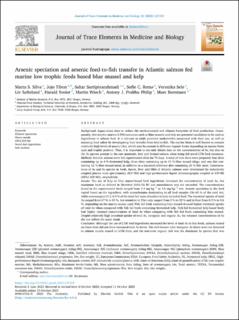| dc.description.abstract | Background Aquaculture aims to reduce the environmental and climate footprints of feed production. Consequently, low trophic marine (LTM) resources such as blue mussels and kelp are potential candidates to be used as ingredients in salmon feed. It is relevant to study potential undesirables associated with their use, as well as assessing food safety by investigating their transfer from feed-to-fish. The marine biota is well known to contain relatively high levels of arsenic (As), which may be present in different organic forms depending on marine biota type and trophic position. Thus, it is important to not only obtain data on the concentrations of As, but also on the As species present in the raw materials, feed and farmed salmon when being fed novel LTM feed resources. Methods Atlantic salmon were fed experimental diets for 70 days. A total of nine diets were prepared: four diets containing up to 4 % fermented kelp, three diets containing up to 11 % blue mussel silage, and one diet containing 12 % blue mussel meal, in addition to a standard reference diet containing 25 % fish meal. Concentrations of As and As species in feeds, faeces, liver and fillet of Atlantic salmon were determined by inductively coupled plasma mass spectrometry (ICP-MS) and high-performance liquid chromatography coupled to ICP-MS (HPLC-ICP-MS), respectively. Results The use of kelp or blue mussel-based feed ingredients increased the concentration of total As, but maximum level as defined in Directive 2002/32 EC and amendments was not exceeded. The concentrations found in the experimental feeds ranged from 3.4 mg kg−1 to 4.6 mg kg−1 ww. Arsenic speciation in the feed varied based on the ingredient, with arsenobetaine dominating in all feed samples (36–60 % of the total As), while arsenosugars (5.2–8.9 % of the total As) were abundant in kelp-included feed. The intestinal uptake of total As ranged from 67 % to 83 %, but retention in fillet only ranged from 2 % to 22 % and in liver from 0.3 % to 0.6 %, depending on the marine source used. Fish fed feeds containing blue mussel showed higher intestinal uptake of total As when compared with fish fed feeds containing fermented kelp. Fish fed fermented kelp-based feeds had higher retained concentrations of total As when comparing with fish fed feeds containing blue mussel. Despite relatively high intestinal uptake of total As, inorganic and organic As, the retained concentrations of As did not reflect the same trend. Conclusion Although the use of LTM feed ingredients increased the level of total As in this feeds, salmon reared on these diets did not show increased total As levels. The well-known toxic inorganic As forms were not detected in salmon muscle reared on LTM diets, and the non-toxic organic AsB was the dominant As species that was retained in salmon muscle, while the organic AsSug forms were not. This study shows that speciation analysis of the LTM resources provides valuable information of the feed-to-fish transfer of As, needed to assess the food safety of farmed Atlantic salmon reared on novel low trophic feeds. | |
